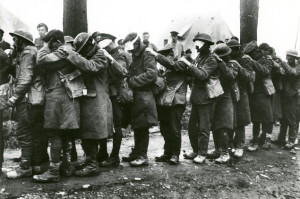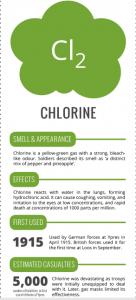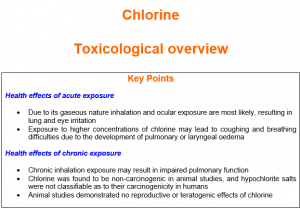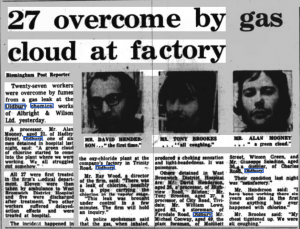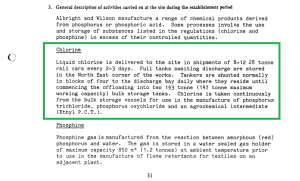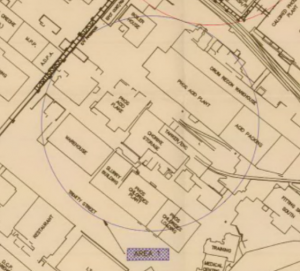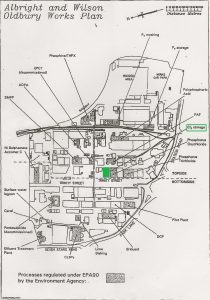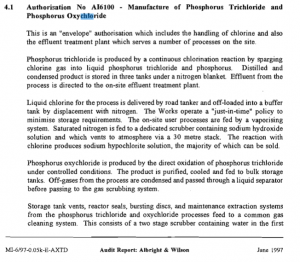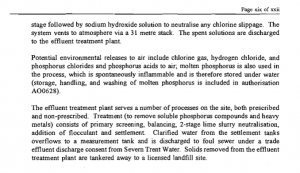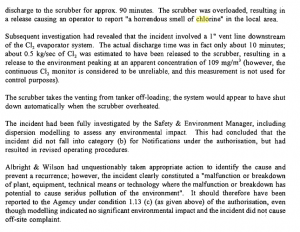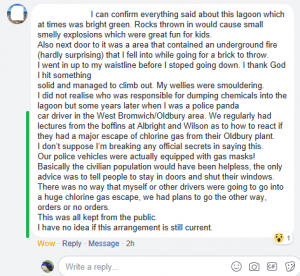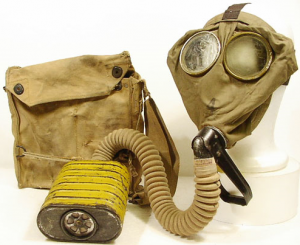If you thought that the threat of coming into contact with chlorine gas was something from the history of the World War 1 trenches, think again. In Oldbury and from the source of a British Government military supplier, it was a very real threat facing the surrounding population from the vile Albright and Wilson Trinity Street chemical factory.
Firstly lets look at the chemical itself. A number of online Health Protection Agency (now Public Health England) pdfs have been published on the nature and risks associated with this chemical.
Concerning the toxicological overview they state the following.
“Summary of Health Effects
Exposure of unprotected personnel to chlorine gas may initially result in eye and lung irritation, the severity of which will be dependent on the concentration and duration of contact.
Relatively minor exposures may result in sensory irritation such as burning of the eyes and throat. These initial symptoms are caused by free-radicals, hypochlorous or hypochloric acid formed by the reaction of chlorine with water in lung or eye tissues.
More significant exposures may lead to coughing and breathing difficulties due to the development of pulmonary and/or laryngeal oedema.
Clearly, exposure to a large concentration of chlorine in an enclosed or poorly ventilated area may cause asphyxiation as a result of decreased oxygen availability.
There is some evidence to suggest that acute exposure may result in long-term pulmonary sequelae (reactive airways dysfunction; RADs) in a small proportion of individuals.”
Albright and Wilson’s use of chlorine stemmed from their production of phosphorus trichloride, phosphorus oxychloride and ethyl P.C.T . It was delivered to the factory via a private rail line spur which was a direct boon from their second world war production supply as a military contractor.
The effects shown in war were clearly a major risk to anyone living near to the site, as well as the hapless employees.
The following article from The Birmingham Post 26th January 1974 shows how 27 employees of Albright and Wilson required hospital treatment after an uncontrolled cloud release of this toxic gas from the oxychloride plant.
“A green cloud of chlorine started to come into the plant where we were working. We all struggled out somehow.”
The threat of the gas was confirmed when the company were required to publish material under new CIMAH legislation, though this was an opportunity to merely promote themselves. Hazardous substance consent legislation also confirmed how the chemical was delivered into the works and the quantities involved. In 1992 the application HS/008 applied for 360 tonnes rising to 720 tonnes.
A plan of the storage area is shown below.
A subsequent consent HS/009 was a much heralded back slapping exercise between this company and the deluded black country development corporation. This removed the threat from rail and instead replaced it with chlorine being delivered by road instead. The quantity on site was reduced, but as evidenced by the factory uncontrolled release, this risk was not depreciated by the continued use of the chemical on site.
This only achieved the desired human shield increase in development land for both parties. Alarms and sirens and leaflets would remain in the consciousness of those living anywhere near to the site, just as they had during wartime raids.
The Environment Agency 1997 report inspection reveals further information on the Albright and Wilson chlorine machine as it then stood.
“Because of the quantities of chlorine, phosphine, and phosphorus used, the site falls under the Control of Industrial Major Accident Hazard Regulations 1984 (CIMAH), and the Control of Industrial Major Accident Hazard (Amendment) Regulations 1990. An Off-Site Emergency Plan has therefore been produced by West Midlands Fire Service Emergency Planning Unit, with the assistance of the Company. “
The production of phosphorus trichloride and oxychloride is explained.
The report interestingly makes reference to another chlorine incident, but also interestingly the manner in which Albright and Wilson sought to conceal what occurred during such events.
“Z408 Report No 96/296 was reviewed. This incident occurred in the chlorine storage/transfer area; the initial incident report, summarised in the SAG minutes, stated that following maintenance a vent valve on the chlorine main had been left open, resulting in a chlorine discharge to the scrubber for approx. 90 minutes. The scrubber was overloaded, resulting in a release causing an operator to report “a horrendous smell of chlorine” in the local area.
Albright & Wilson had unquestionably taken appropriate action to identify the cause and prevent a recurrence; however, the incident clearly constituted a “malfunction or breakdown of plant, equipment, technical means or technology where the malfunction or breakdown has potential to cause serious pollution of the environment”. It should therefore have been reported to the Agency under condition 1.13 (c) (as given above) of the authorisation, even though modelling indicated no significant environmental impact and the incident did not cause off-site complaint. “
As a final footnote to this post it is worth publishing how the emergency services were tasked with the event of a major incident of such a chlorine release at the site. Not only does the author confirm his recollections of rattlechain lagoon, but as a former police officer, how gas masks were carried in the patrol car and how information was not communicated to the general public.
“Basically the civilian population would have been helpless, the only advice was to tell people to stay in doors and shut their windows. “
It would appear that very little has actually changed about “advice” in the intervening years, though there are no longer bulk deliveries of Cl2 down the rail tracks and according to Solvay, production of the two chloride plants was shut down, though no amendment to the substance consents ever appears to have been made.
Today the political class and Government agents are quick to tell us about “threats” from foreign lands. 100 years ago it was the Germans. At times when it suited them, it has been Middle East “allies” who then morph into enemies with “weapons of mass destruction”. Today it suits them to have the pesky vlads dropping canisters in the vain hope that they think that we believe they are making us feel safe- but never talk about the chemical industry of Britain and its real undiminished threat to civilian populations- perhaps that would not be patriotic- even though the current site operators are Belgian owned.
Perhaps beyond the bullshit “reassurances” of calendars pushed through doors and emergency practice drills, this might help local residents, 100 years on after World War one actually ended. You can buy them on ebay quite reasonably. All the best of British! 😛


